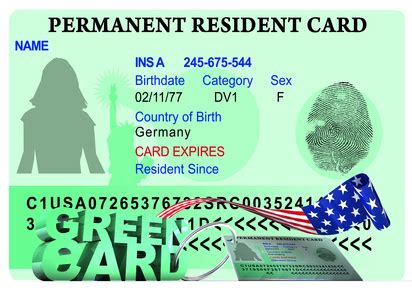
A Comprehensive Guide to Obtaining Permanent Residency in the United States
Welcome to our blog post on understanding permanent residency in the United States. If you’ve ever dreamed of living and working in the land of opportunity, then obtaining permanent residency may be your first step towards achieving that goal. In this article, we will explore the eligibility requirements for permanent residency, discuss the various pathways to obtaining it, and guide you through the process of gathering and preparing the required documentation. Additionally, we will delve into the application submission and processing timeline, offer insights on attending the green card interview, and finally, discuss what happens once you receive your permanent residency and the next steps you should take. So let’s dive in and uncover the secrets to securing your place in America.
Understanding Permanent Residency in the United States
Permanent residency, also known as a green card, is an immigration status that allows individuals to live and work permanently in the United States. It is a highly sought-after status for many immigrants who wish to establish a long-term presence in the country. In this blog post, we will explore the various aspects of permanent residency, including eligibility requirements, different pathways, required documentation, application submission and processing timeline, the green card interview, and what happens once you receive permanent residency.
Eligibility Requirements for Permanent Residency
Before applying for permanent residency, it is essential to understand the eligibility requirements set by the U.S. government. The most common pathway to permanent residency is through employment sponsorship or family sponsorship. For employment-based permanent residency, individuals must have a job offer from a U.S. employer who is willing to sponsor their application. Family-sponsored permanent residency involves being petitioned by a close family member who is either a U.S. citizen or a current green card holder. Additionally, certain individuals may be eligible for permanent residency through refugee or asylum status, diversity visa lottery, or other special programs.
Navigating the Different Pathways to Permanent Residency
Once you determine your eligibility for permanent residency, it is crucial to understand the different pathways available to you. The employment-based pathway requires a labor certification process, where the employer must prove that there are no qualified U.S. workers available for the job. On the other hand, the family-sponsored pathway involves submitting a petition to the U.S. Citizenship and Immigration Services (USCIS), along with evidence of the familial relationship. Other pathways, such as the diversity visa lottery, have specific criteria and require successful participation in the annual lottery program. Understanding these pathways will help you choose the most appropriate route to permanent residency.
Eligibility Requirements for Permanent Residency
To be eligible for permanent residency in the United States, there are certain requirements that individuals must meet. These requirements vary depending on the category under which an individual is applying. The most common categories for permanent residency include family-sponsored, employment-based, and humanitarian-based applications. It is important to understand these eligibility requirements to ensure a successful application process.
For the family-sponsored category, individuals must have a qualifying relationship with a U.S. citizen or permanent resident who is willing to sponsor their application. This includes immediate relatives such as spouses, parents, and unmarried children under the age of 21. Other family relationships may also be eligible, but the preference categories and available visa numbers may vary.
In the employment-based category, individuals must have a job offer from a U.S. employer who is willing to sponsor their application. The employer must demonstrate that they have unsuccessfully tried to recruit U.S. workers for the position and that hiring the foreign national will not negatively impact the U.S. labor market. Different preference categories exist within the employment-based category, each with specific requirements and visa allocations.
The humanitarian-based category includes refugees, asylees, and victims of trafficking or crime who may be eligible for permanent residency. These individuals must meet specific criteria related to their circumstances and provide supporting documentation to demonstrate their eligibility for permanent residency.
In addition to the specific requirements for each category, all applicants for permanent residency must meet certain general eligibility criteria. This includes being admissible to the United States, which means they do not have any disqualifying factors such as criminal convictions or certain medical conditions. Applicants must also undergo a thorough background check and medical examination as part of the application process.
Eligibility Requirements in Summary:
- Family-sponsored category: Qualifying relationship with a U.S. citizen or permanent resident.
- Employment-based category: Job offer from a U.S. employer and demonstration of unavailability of U.S. workers.
- Humanitarian-based category: Meeting specific criteria related to refugees, asylees, victims of trafficking or crime.
- General eligibility criteria: Admissibility to the United States, background check, and medical examination.
Conclusion:
Understanding the eligibility requirements for permanent residency in the United States is crucial for a successful application process. Whether applying through the family-sponsored, employment-based, or humanitarian-based category, individuals must meet specific criteria and provide supporting documentation. Additionally, all applicants must meet general eligibility criteria related to admissibility, background checks, and medical examinations. By fulfilling these requirements, individuals can increase their chances of obtaining permanent residency and pursuing their dreams in the United States.
Navigating the Different Pathways to Permanent Residency
When it comes to obtaining permanent residency in the United States, there are several pathways that individuals can explore. Understanding these different pathways is essential for navigating the complex immigration system. Whether it’s through employment, family ties, or humanitarian reasons, each pathway has its own set of eligibility requirements and documentation that applicants must gather and prepare. In this blog post, we will explore the various pathways to permanent residency and provide guidance on how to successfully navigate them.
Employment-Based Pathways
One pathway to permanent residency is through employment. The United States offers different visa categories for skilled workers, professionals, and investors who wish to live and work in the country permanently. For example, the EB-1 visa is designed for individuals with extraordinary abilities in the sciences, arts, education, business, or athletics. The EB-2 visa is for professionals with advanced degrees or exceptional abilities, while the EB-5 visa is available for foreign investors who are willing to make a substantial investment in a U.S. business. Understanding the specific eligibility requirements for each visa category is essential for a successful application.
Family-Based Pathways
Another common pathway to permanent residency is through family ties. U.S. citizens and permanent residents can sponsor certain family members for a green card, allowing them to become eligible for permanent residency. Immediate relatives, such as spouses, parents, and unmarried children under the age of 21, have priority in the family-based immigration system. Other family members, such as siblings and married children, fall into preference categories and may experience longer waiting times. Gathering the necessary documentation to prove the familial relationship is crucial in this pathway.
Humanitarian-Based Pathways
In certain circumstances, individuals may qualify for permanent residency through humanitarian-based pathways. Examples include refugees and asylum seekers who have been granted asylum in the United States. Additionally, victims of human trafficking, crime, or domestic violence may be eligible for a green card under special provisions. These pathways typically require applicants to demonstrate that they meet specific criteria and provide supporting documentation to substantiate their claims. Understanding the requirements for each humanitarian-based pathway is crucial for those seeking permanent residency on these grounds.
Conclusion
Navigating the different pathways to permanent residency in the United States can be a complex process. Whether it’s through employment, family ties, or humanitarian reasons, understanding the specific eligibility requirements and gathering the necessary documentation is essential for a successful application. By familiarizing yourself with the various pathways and seeking professional advice when needed, you can increase your chances of obtaining permanent residency and taking the next steps towards building a new life in the United States.
Gathering and Preparing Required Documentation
When it comes to applying for permanent residency in the United States, one crucial step in the process is gathering and preparing the required documentation. This step is essential as it ensures that your application is complete and includes all the necessary information to support your eligibility for permanent residency. By organizing your documents beforehand, you can streamline the application process and avoid unnecessary delays or rejections.
So, what are the key documents you need to gather?
To start with, you will need to provide proof of your identity, such as a valid passport, birth certificate, or driver’s license. Additionally, you will need to gather evidence of your immigration status, which may include your current visa or any previous immigration documents you have obtained.
Another crucial set of documents to gather is those related to your employment and financial situation. This may involve acquiring letters from your current or previous employers, detailing your job title, employment dates, and salary. You should also include pay stubs, tax returns, and bank statements to demonstrate your financial stability and ability to support yourself in the United States.
It is also important to provide documentation relating to your family and marital status.
This may include marriage certificates, divorce decrees, and birth certificates for any dependents you have. If you are applying for permanent residency based on a family relationship, you may need to gather additional documents, such as a marriage certificate for a spouse or birth certificates for children.
In addition to these documents, it is important to gather any supporting evidence that strengthens your case for permanent residency.
This could include recommendation letters, awards, certificates, or any other documents that highlight your achievements, contributions, or community involvement.
It’s important to follow the specific instructions outlined by the U.S. Citizenship and Immigration Services (USCIS) regarding the required documentation for your particular immigration category.
By carefully reviewing the instructions and ensuring you have all the necessary documents, you can avoid any unnecessary setbacks in the application process.
Submitting the Application and Processing Timeline
Once you have gathered and prepared all of the required documentation for your permanent residency application in the United States, the next step is to submit it. The submission process can vary depending on the pathway you are taking, whether it is through family sponsorship, employment, investment, or any other means. It is crucial to thoroughly review the specific instructions for your chosen pathway to ensure that you are submitting your application correctly.
When submitting your application, it is important to pay close attention to the processing timeline. The processing time can vary depending on a variety of factors, including the type of visa you are applying for and the current backlog of applications. It is essential to be patient during this process, as it can take several months or even years for your application to be processed.
During the processing timeline, there are certain steps that will occur. After submitting your application, it will be reviewed by the United States Citizenship and Immigration Services (USCIS). They will conduct a thorough examination of your application and supporting documents to determine your eligibility for permanent residency.
- Background Check: As part of the processing timeline, the USCIS will conduct a background check to ensure that you meet the requirements for permanent residency. This check may include reviewing your criminal history, immigration history, and other relevant information.
- Biometrics Appointment: In some cases, you may be required to attend a biometrics appointment. During this appointment, your fingerprints, photograph, and signature will be taken for identification purposes.
- Interview: Depending on your pathway and individual circumstances, you may be required to attend an interview with a USCIS officer. This interview is an opportunity for the officer to ask you questions about your application and supporting documents, as well as assess your eligibility for permanent residency.
- Approval or Denial: After the USCIS has reviewed your application and completed all necessary checks and interviews, they will make a decision regarding your permanent residency. If your application is approved, you will receive a notice of approval and further instructions on the next steps. However, if your application is denied, you will be informed of the reasons for the denial and given the opportunity to appeal the decision, if applicable.
It is important to note that the processing timeline can be subject to change and may vary depending on individual circumstances. It is recommended to regularly check the USCIS website for updates on processing times and any changes to the application process.
| Pathway | Processing Time |
|---|---|
| Family Sponsorship | Approximately 12-15 months |
| Employment | Varies depending on visa category and demand |
| Investment | Approximately 24-30 months |
| Diversity Visa Lottery | Varies; typically announced in May each year |
It is crucial to be well-prepared and organized when submitting your permanent residency application. Ensure that you carefully follow all instructions, submit the required documentation, and meet all deadlines. By doing so, you can increase your chances of a smooth application process and a successful outcome.
Attending the Green Card Interview
One of the pivotal steps in the process of obtaining permanent residency in the United States is attending the green card interview. This interview plays a crucial role in determining whether an applicant meets the requirements for permanent residency. It is essential to be well-prepared and knowledgeable about what to expect during this interview.
Before attending the green card interview, it is important to gather and prepare all the required documentation. This includes proof of identity, such as a valid passport, as well as any supporting documents related to your application. These documents may vary depending on your individual circumstances, so it is crucial to review the specific requirements outlined by the U.S. Citizenship and Immigration Services (USCIS).
During the green card interview, applicants will be questioned by an immigration officer in order to verify the information provided in their application. The purpose of this interview is to assess the credibility and eligibility of the applicant. It is essential to answer all questions truthfully and provide accurate information. Being well-prepared can help alleviate any nervousness and ensure a smoother interview process.
Here are some key points to keep in mind when attending the green card interview:
- Arrive on time: Make sure to arrive at the designated location on time or even a few minutes earlier to avoid any unnecessary stress.
- Dress appropriately: Dress in formal attire to demonstrate your seriousness and respect for the interview process.
- Be organized: Bring all the required documents in a well-organized manner to present them easily when requested.
- Stay calm and composed: It is normal to feel nervous during the interview, but try to remain calm and composed while answering the questions.
- Listen carefully and answer truthfully: Pay close attention to the questions asked and provide truthful and concise answers.
- Be respectful: Show respect towards the immigration officer and maintain a polite and professional demeanor throughout the interview.
- Ask for clarification if needed: Do not hesitate to ask for clarification if you do not understand a question. It is better to seek clarification than to provide incorrect information.
After the green card interview, the USCIS officer will evaluate all the information provided and make a decision on the applicant’s permanent residency status. If approved, the applicant will receive a notice in the mail indicating the approval and the next steps to receive their permanent residency card.
Attending the green card interview is an important milestone in the journey towards permanent residency in the United States. By being well-prepared, composed, and truthful during the interview, applicants can increase their chances of a successful outcome and moving forward in the process of obtaining permanent residency.
Receiving Permanent Residency and Next Steps
After successfully completing the green card interview and having your application approved, you will receive your permanent residency in the United States. This is an exciting milestone in your journey towards living and working in the country permanently. However, there are still important steps and considerations to keep in mind once you have received your green card.
One of the first things you should do is notify the U.S. Citizenship and Immigration Services (USCIS) of any changes in your address within 10 days of moving. This is a requirement for all permanent residents, as failing to do so may result in penalties or even a loss of your permanent resident status. You can easily update your address online through the USCIS website.
- Notify USCIS of any changes in your address within 10 days of moving
- Apply for a Social Security Number (SSN)
- Explore Employment Opportunities
Another important step to take is to apply for a Social Security Number (SSN). An SSN is a unique identifier issued by the Social Security Administration and is essential for various purposes, including employment, opening a bank account, and filing tax returns. To apply for an SSN, you will need to visit your local Social Security office and provide the necessary documents, such as your green card, passport, and proof of identity.
Once you have your permanent residency, it’s a good time to explore employment opportunities in the United States. As a permanent resident, you have the right to work and live in the country indefinitely. This opens up a wide range of career options and allows you to pursue your professional goals. You can start searching for job openings online, networking with professionals in your field, and attending job fairs to find potential employers who are willing to sponsor employees with permanent residency.
| Next Steps | Actions |
|---|---|
| Apply for U.S. Citizenship | Once you have fulfilled the eligibility requirements, you can consider applying for U.S. citizenship |
| Sponsor Immediate Family Members | If you have immediate family members who wish to join you in the United States, you can explore the possibilities of sponsoring them for permanent residency |
| Stay Abreast of Immigration Laws and Policy Changes | As an immigrant, it’s crucial to stay informed about any changes or updates in immigration laws and policies that may affect your status as a permanent resident |
Looking beyond the immediate steps, receiving permanent residency opens up new opportunities for you and your family. Once you have fulfilled the eligibility requirements, you may consider applying for U.S. citizenship. This grants you additional rights and benefits, such as the ability to vote, obtain a U.S. passport, and petition for family members to join you in the United States.
If you have immediate family members who wish to join you in the United States, such as a spouse or unmarried children under the age of 21, you can explore the possibilities of sponsoring them for permanent residency. Keep in mind that the process may vary depending on the relationship and individual circumstances of your family members.
Finally, it’s important to stay informed about any changes or updates in immigration laws and policies that may affect your status as a permanent resident. Immigration laws can change over time, and it’s your responsibility to stay compliant with any new requirements or obligations. This can be done by regularly checking the USCIS website or consulting with an immigration attorney who can provide guidance on navigating the complex immigration system.
Frequently Asked Questions
1. What are the eligibility requirements for obtaining permanent residency in the United States?
To be eligible for permanent residency in the United States, you typically need to meet certain criteria, such as having a qualifying family relationship with a U.S. citizen or permanent resident, employment-based sponsorship, or qualifying under refugee or asylum status. You will also need to meet specific requirements related to admissibility, criminal history, and health.
2. What are the different pathways to permanent residency in the United States?
There are various pathways to obtain permanent residency in the United States, including family-sponsored immigration, employment-based immigration, the Diversity Visa Program, and refugee or asylum status. Each pathway has its own eligibility requirements and application processes.
3. What documents are required when applying for permanent residency?
When applying for permanent residency, you will need to gather and prepare several documents, such as a valid passport, birth certificate, marriage certificate (if applicable), proof of financial support, evidence of a qualifying relationship or employment, and other supporting documents specific to your situation.
4. How long does the application process for permanent residency usually take?
The processing time for a permanent residency application can vary depending on a range of factors, such as the pathway you are applying through, USCIS workload, and the completeness of your application. Generally, it can take several months to years to process an application. It is important to stay updated on the current USCIS processing times.
5. What happens during the green card interview?
The green card interview is a crucial step in the permanent residency application process. During the interview, a USCIS officer will review your application, ask you questions regarding your eligibility and supporting documents, and assess your English language proficiency. It is important to be prepared, truthful, and provide all requested information.
6. What happens after receiving permanent residency?
After receiving permanent residency, you will be issued a green card, which serves as proof of your status as a permanent resident. You will have certain rights and responsibilities, such as the ability to live and work permanently in the U.S., enroll in certain government programs, and apply for U.S. citizenship after meeting the eligibility requirements.
7. What are the next steps after obtaining permanent residency?
After obtaining permanent residency, you may want to consider taking steps towards U.S. citizenship, if it aligns with your goals. This involves meeting certain criteria, such as maintaining continuous residence, demonstrating good moral character, and passing an English and civics test. It is important to understand the benefits and requirements of becoming a U.S. citizen before proceeding.





